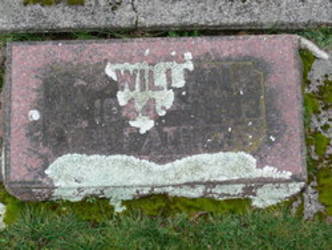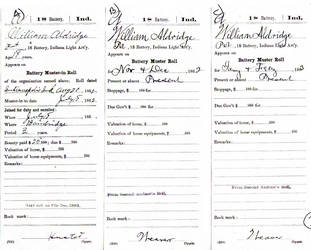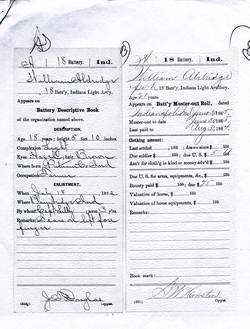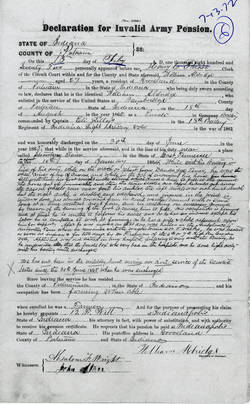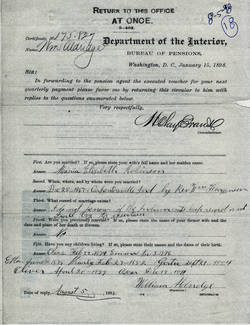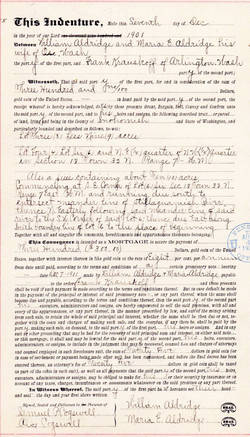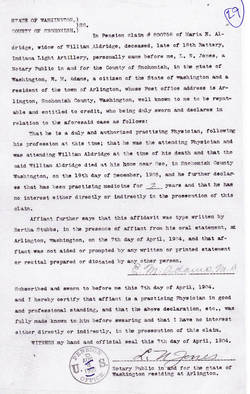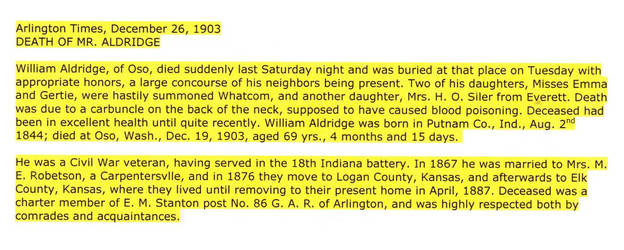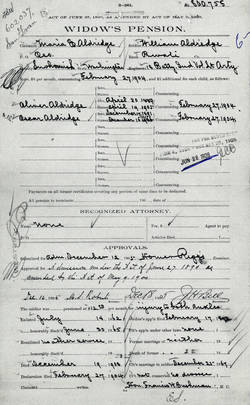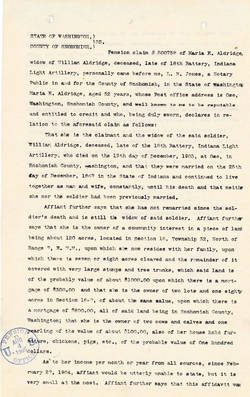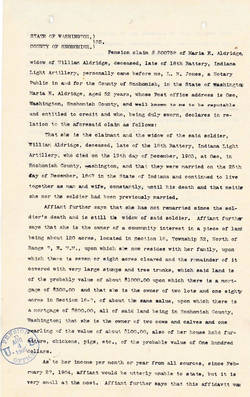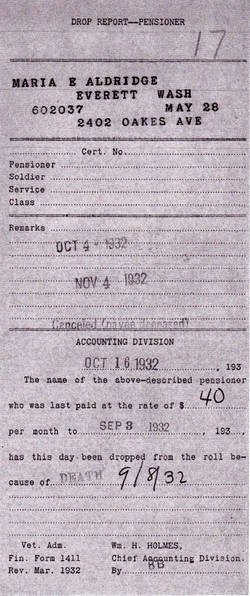William Aldridge
Representing: Union
G.A.R Post
- E. M. Stanton Post #86 Arlington (Haller City), Snohomish Co. WA
Unit History
- 18th Indiana Light Artillery
Full Unit History
18th BATTERY INDIANA VOLUNTEER LIGHT ARTILLERY
Organized: Summer, 1862 Indianapolis, IN
Mustered In: 8/24/62 Indianapolis, IN
Mustered Out: 6/30/65 Indianapolis, IN
Regimental History
REGIMENTAL HISTORY:
The 18th, a three year western theater battery departed Indianapolis, IN shortly after its 8/24/62 Federal muster. Taking to the field en route to Louisville, KY were 151 enlisted men and officers.
Once in Kentucky the unit marched to Bowling Green via Frankfort and thence to Gallatin, TN. Upon the occupation Murfreesboro it moved to that location. It remained there until June, 1863 when it moved to Tullahoma. After that Rebel forces were encountered at Hoovers Gap with the brigade to which the 18th was attached driving him back upon his reserves. During this action the battery opened such a warm fusillade of fire that the Confederates were driven from the field.
Chattanooga, TN came next. Once there the 18th saw action at Chickamauga (loc. Date Sept 19-20 1963). During this bloody encounter the batter aided in bloodily repelling a charge by forces under Confederate General Longstreet.
After Chickamauga the batter moved up the Tennessee River to guard fords (fords or forts?). In October it was in pursuit of Wheeler's Confederate cavalry in the Sequatchie Valley. During this movement, the Rebels were found and routed at Thompson's Cove. Three days later he was again overtaken and the enemy driven in confusion through McMinnville.
The 18th next moved to Huntsville, AL, but found itself retracing its steps to Chattanooga, TN where, after the battle of Missionary Ridge it was sent - along with its division - to the relief of Knoxville. This movement resulted in their seeing action at Mossy Creek, Fair Garden and Dandridge.
In May, 1864 the battery marched with Union Gen. W.T. Sherman toward Atlanta, GA. During this campaign it was active at Resaca, Stilesboro, Cassville, Lost Mountain, Vining's Bridge, Newnan, Hopkinsville and West Point. After the Rebel evacuation of Atlanta it joined in the pursuit of the retreating Rebels before proceeding to Nashville.
From Nashville the unit moved to Hopkinsville, KY where it was again engaged with the enemy. It then marched to Eastport, MS and from there to Selma, AL. Engaging Rebel forces there, it then took part in the raid through Alabama and Georgia to West Point and Macon where the greybacks were defeated and a large quantity of military store destroyed.
The 18th next moved to Chattanooga. From there it marched to Nashville. Its next stop was Indianapolis for final muster and disbandment.
Regimental Losses: 1 officer killed or mortally wounded; 0 officers died of disease accidents, etc.; 10 enlistment killed or mortally wounded; 31 enlisted men died of disease accidents, etc.
Soldier History
SOLDIER:
Residence: Floyd Putnam Co., IN Age: 18 yrs.
Enlisted/Enrolled: 7/18/62 Bainbridge Putnam Co., IN Rank: Pvt.
Mustered In: 7/18/62 Bainbridge Putnam Co., IN
Mustered Out: 6/30/65 Indianapolis, IN
Highest Rank: Pvt.
Family History
PERSONAL/FAMILY HISTORY:
William Aldridge’s year of birthing was likely 1844. No date or month has been found in available documents.
William was reportedly born in Groveland, Putnam County, Indiana. His father, also named William, (b. 1810 TN) was a farmer. His mother's name was Mary A. (b. 1812 KY). No maiden name has been discovered for her.
At the time of the 1850 U.S. Census the Aldridge family was still residing in Putnam County, but by then not in Groveland, but in or near the community of Floyd. The Aldridge children by that date were noted as: Oliver P. (b. 1831 IN), Amanda (b. 1835 IN), Louisa (b. 1837 IN), Hannah (b. 1839 IN) William (b. 1844 IN), Mary A or R. (b. 1846 IN) and Lucinda (b. 1850 IN). A decade later in the same location the household was noted as home for William and Mary, plus children William (here noted as born in 1845), Mary R. Lucinda and a new name, Alice (b. 1853 IN).
On 7/18/62 in Bainbridge, Putnam County, IN "young" William enlisted in the U.S. Army for three years. His unit of choice was Captain Lilly's 18th Battery Indiana Light Artillery. His vital stats as noted at the time were: Age = 18; Height = 5'10"; Complexion = light; Eyes = hazel and Hair = brown. In terms of remarks, it was added that he had a "scar on his left forefinger. William's occupation was listed as farmer. For enlisting he received a $100 bonus or "bounty" $25 of which was paid up front with the balance to come incrementally on later dates. Private Aldridge's muster date was the same as that of his enlistment.
By August 30, 1862 William and the 18th were in Indianapolis, IN. From that point until the end of the year Private Aldridge was present for duty. The same held true throughout the calendar year 1863 with the Nov. /Dec. entry noting that Private Aldridge et. al. were then stationed at Mossy Creek, TN.
1864. This seemed to be another good year for Private Aldridge in terms being present for duty and general health matters although there was a horse-related accident the results of which would plaque him for years. More on this later.
Maybe part of the Private Aldridge's good health can be attributed to the fact that was due to the fact that his battery was not sitting idle in some stagnant swamp of a camp, but almost constantly on the move. For example, in January and February it was stationed at Madisonville in east Tennessee. From March until August it was located near Cleveland, TN, by September and October it was again afield. September found it at Cartersville, GA while in October it was at Calhoun, GA. The last two months of the year found the 18th back in TN in camp at Webster.
1865. The last months of the War. During January and February the 18th was stationed at Waterloo, AL. No further listings are available prior to final muster on June 30th at Indianapolis, IN.
Military life behind him William settled in Groveland, IN, the community in which he had been born.
****************************************************************************
The next milestone in William's life came on Christmas day in 1867 when, in Carpenterville (a community name that no longer exists on contemporary maps), IN he wed to Maria/Mariah Elizabeth Robinson (b. 1852/'52 TN). The union would produce ten children, seven of whom were living as of 1900. The known children's names are: Ellen O. (b. 1872 IN), Clara (b. 2/22/74 IN), Sarah Emma (b. 11/3/76 IN), Mary Etta (b. 6/8/79 IN), Charley/Charly (b. 1882 KS), Gertrude "Gertie" (b. 1884 KS), Ruby (b. 1888 KS), Oliver (b. 4/20/89 KS or WA) and Oscar/Orean (b. 12/17/91).
As noted by the birthplaces of the Aldridge children, the family made several moves during their child-producing years. At some point between the birth of Mary E. in 1879 and the taking of the U.S. Census in 1880 the Aldridge’s removed from Groveland, Indiana and resettled in Kansas. Why the move was made is not documented, but likely it was because of the availability of open farmland. They would remain in Kansas for approximately ten years and likely resided in more than one location as communities document ally mentioned include Fremont, Lyon County, Emporia, Lyon County, and Howard in Elk County. It was at this latter location that circa 12/28/86 the family home and its contents were partially destroyed by fire. Perhaps it was this loss that prompted the Aldridge’s to leave Kansas and move to Washington Territory/State as it was there as of July of 1889 they were living in or near the community of Glendale located in the western Washington county of Snohomish. In Washington the Aldridge’s would remain in and around the Arlington area of Snohomish County for the remainder of their lives.
In addition to Glendale, other Snohomish County locales noted are Tafton and Oso. Whether or not these are references to different places where the family resided or different perspectives of the same one is not clear.
Let us now revisit William's days of Civil War soldiering. As mentioned earlier, there had been a horse-related accident. As early as the month of March in 1870 while still residing in Groveland, IN William had begun the paperwork process to obtain a U.S. Government disability pension based on physical problems which he traced back to his period of service as a soldier. According to his telling, on or about 1/10/64 with his battery and in the line of duty near Strawberry Plains in eastern Tennessee while on the march - either advancing upon or retreating from Dandridge, TN and acting as wheel driver of one of the caissons, in the act of mounting his horse it fell on him. Unfortunately, as the horse fell, Private Aldredge's foot caught in the saddle stirrup causing him to fall to the ground, too. The horse immediately got up, but before William could do so the team started running causing the caisson wheels to run over both of his ankles. The left ankle was not injured badly, but the right joint was seriously bruised and damaged. As a result of this from then on William found walking to be very difficult, a condition which would follow him until the end of his days and apparently as of the early 1870s lead to him being granted a monthly stipend of $4 which, in turn, would increase to $12 by the time of his death.
Obtaining a pension increase was not an easy process. Claimants often had to appear before a screening board of physicians. These screening boards were held, not in remote rural areas such as where William resided, but in nearby cities or towns. In the case of William, the boards were convened south of where he lived in the Snohomish County City of Everett or, even worse, south of there in Seattle King County. Responding to his having failed to attend one of these screenings on 12/24/90 William related the following reasons for not attending a required examination. "The first meeting was passed before I received the order. The second board I was physically unable to attend, their meeting coming the day before the general election. I could not get to the place of the meeting in time after voting on November 6th. The (next) meeting I reported to the doctor’s office and was informed the old board was dissolved. I then went to another doctor's office and he told me the new board was not organized. I then wrote to the head doctor that I did not report to the board since the roads being in such terrible poor condition to get to the railroad and trains failing to connect that it took me four days to get to Everett and back here (Oso), so I could not afford to make another trip until I could ascertain if a new board of examiners was organized."
William died 12/19/03 at his home located near Oso, Snohomish County, WA leaving behind a widow and two minor children. While available documentation indicates he was being tended to by a physician at the time of his passing, no details are given regarding the cause of his death. Burial was in nearby Arlington's Harwood Cemetery.
*****************************************************************************
Following the death of William, during the early months of 1904, Maria initiated the paperwork to continue to receive at least a portion of his pension. This necessitated she and son William appearing before a notary public to attest to her financial resources and assets. During this process it was shown that she had half interest in approximately 125 acres of land plus another half interest in a lot. Of the former, six or seven acres were cleared, with the remainder containing stumps or logs from which she received an income of perhaps $50 to $75 per year. A combined source of her incomes from all the property was not more than $100 per year. On 12/20/05 Maria was granted a pension of $8 per month.
As of 1910 Maria was still in Oso with youngest son, Oscar, under her roof. (Interestingly, in this census she noted she had borne eight children, seven of whom were living.) By 1920, however, she had moved southward to the City of Everett. Oscar was still living with her. The same household makeup existed in 1930.
Maria/Mariah Elizabeth died in Everett, WA on September 8, 1932. Her address at the time was noted as being 2402 Oakes Avenue. Her pension at passing was $40 per month. She was buried in Arlington beside William.
Cemetery
Buried at Harwood Cemetery Arlington
